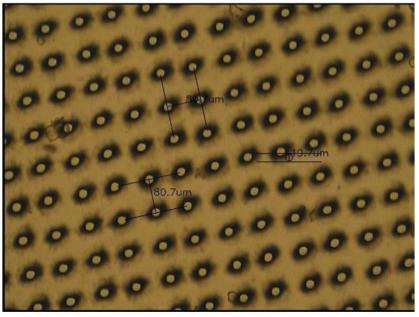NOVEL BIO MATERIAL FILM TO HELP TREAT AGE-RELATED MACULAR DEGENERATION, A MAJOR CAUSE OF BLINDNESS
“Development of a clinically relevant prototype cell transfer sheet (CTS) to act as an artificial Bruch’s membrane in the treatment of Age related Macular Degeneration (AMD)”
TSB Technology-inspired feasibility study (in association with University of Liverpool)
Background
AMD is the leading cause of blindness in the Western world affecting an estimated 30 million people with only a small portion of patients that can be symptomatically treated, temporarily maintaining the status quo, with no causal treatment. Alteration of the natural substrate for retinal pigment epithelial (RPE) cells, the so-called Bruch’s membrane (BM), is regarded as crucial and causal event in AMD. Healthy BM exhibits a multi-component morphology that provides for cell specific adhesion, appropriate mechanical stability and allows for nutrient diffusion from the underlying blood vessels, all characteristics that are crucial for survival and phenotype maintenance of RPE cells.
Challenge
The challenge was to develop a highly efficient cell transfer sheet (CTS) composed of materials that are non-biodegradable and exhibit long-term biocompatibility, support RPE cell function and survival and maintain the differentiated state of cells. Ideally the CTS would be ultrathin (<10 µm), permeable to nutrients, amenable to sub-retinal transplantation, promote synthesis of extracellular matrix and a new basal lamina. Biomer, in collaboration with the University of Liverpool has developed a novel biomaterial film substrate capable of attachment, proliferation and maintenance of RPE and RPE-like cells in vitro.
Study
The feasibility study was designed to evaluate a laser micromachining process to create the porosity necessary for nutrient transport without compromising the integrity of the biomaterial film to allow the manufacture of clinically relevant prototype samples. A specialist subcontract laser machining company was employed to essentially “drill” holes into a series of polymeric films of varying diameter and pitch. The resultant films were evaluated by physical, chemical and biological techniques to determine if the processing had any detrimental effects on the films and whether we have been able to achieve the desired nutrient transport.
Outcome
The study has demonstrated that:
1. Laser micromachining can be used to create a controlled porosity in a biomaterial film (fig.1) without any observable detrimental effects to the surface chemistry of that substrate
2. The laser processing can be used to create a novel ‘delivery system’ for the populated CTS by cutting a round border in situ (fig.2).
3. The uniform ‘hole’ geometry and pitch generated by the laser processing is such that there are no gross losses in tensile strength up to 200% elongation, far in excess of anticipated elongation during removal of the CTS from the culture plate.

Figure 1 20um holes/80um pitch

Figure 2 CTS with in situ cut border
4. All hole/pitch combinations were non-cyctotoxic and were submitted for cell proliferation study. These studies showed that each of the ‘hole’ geometry/’hole’ pitch combinations will support the attachment and proliferation of aRPE-19 cells but that there are significant differences in terms of monolayer formation.
5. The ‘hole’ geometry/’hole pitch’ are of sufficient size and density to support nutrient transport across the substrates.

Figure 3 Control

Figure 4 20um hole/80um pitch
Figures 3 and 4 illustrate the cell growth on control versus 20μm hole/80μm pitch film sample at 3 days post seeding.
6. Whilst each of the films supports the growth and proliferation of the aRPE-19 cells, at 6 days post seeding it was observed, using nuclear staining (fig.5), that the two larger porosity films showed evidence of cells either ‘tracking’ or ‘falling’ down the holes and potentially occluding them or delaying the point of monolayer formation.

Figure 5. nuclear staining
7. The smallest hole/pitch combination shows no evidence of cell loss through porosity and equivalence with the control sample in terms of proliferation suggesting that laser micromachining will support the manufacture of clinically relevant prototype CTS.
Impact
The study marks a significant milestone in the development of a Cell Transfer Sheet to act as an artificial Bruch’s membrane in the treatment of AMD.
The use of a laser micromachining process provides a clean, fast and economical physical process to create both porosity and also to generate the CTS delivery system for the surgeon in situ. If we were unable to create the porosity within the CTS, then the potential of the CTS approach to the treatment of AMD would remain unfulfilled.
The next phase of development will be to bring the technology from the laboratory to preclinical.

